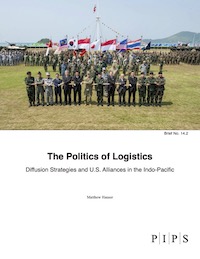Policy White Papers
2021-2022
Coordinated Chaos: Synchronized Cyberwarfare and Disinformation Attacks

by Lucas Hauser
White Paper (pdf)
Video Briefing
In the future, adversaries will conduct complex attacks against the United States that synchronize cyberattacks with disinformation operations to manufacture political crises. Cyberattacks trigger the crisis, while tailored disinformation manipulates the public response. The coordinated attack intensifies domestic divisions, encourages conflict and violence, and cripples the government’s ability to act, thus endangering the U.S. political system’s ability to respond to crises. The U.S. national security community often views cyberwarfare and disinformation as independent threats, creating a vulnerability to coordinated cyber-disinformation attacks. This unpredictable threat requires a coordinated response from all levels of government. To understand this threat, the United States government should hold a series of interagency and federal and local tabletop exercises and wargames so relevant actors can begin to prepare for this complex form of attack.
The Politics of Logistics: Diffusion Strategies and U.S. Alliances in the Indo-Pacific

by Matthew Hauser
White Paper (pdf)
Video Briefing
Military logistics in the Indo-Pacific face new technological threats but also offer political opportunities for the United States. China’s growing long-range missile and sensor capabilities endanger Washington’s ability to supply American, allied, and partner forces in the region. An effective response to threats is the diffusion of logistics. Spreading supply lines across platforms and in geographic space makes them more difficult for China to target militarily. More importantly, logistics diffusion also has the potential to strengthen regional U.S. military partnerships through new cooperation agreements that allow for dispersing, sharing, and coordinating on logistical capabilities. These agreements would create a political dilemma for Beijing. Any attempt to degrade U.S. logistical capabilities in the Indo-Pacific during a conflict would risk horizontal escalation with other states in the region.
Swarmed States: The Impact of Small Loitering Munitions on Weak Regimes

by Delharty Manson
White Paper (pdf)
Video Briefing
Small loitering munitions are armed, autonomous drones that provide easily transportable, rapid, and precise air power for individual users. In the hands of malign actors, small loitering munitions will be used to advance their political goals. Autocrats will use loitering munitions to entrench their power while non-state groups will have a new tool to challenge and destabilize weak regimes. Fragile states lack the funds and technical capacity to effectively combat the use of small loitering munitions. But there is an opportunity to limit the proliferation of these weapons. The United States can curtail proliferation by expanding the Department of State’s weapons removal and abatement programs and incorporating small loitering munitions into regional conventional arms treaties such as the 1996 Wassenaar Agreement.
Unsustainable Futures: Cycles of Environmental Violence
by Cora Martin
White Paper (pdf)
Video Briefing
In the aftermath of civil war, when countries’ environmental institutions are weakest, bad actors take advantage of the conflict-free environment to open illicit industries in protected forests. The resulting deforestation disrupts socioeconomic systems, amplifies poverty, and displaces communities, which increases the likelihood of renewed conflict or civil war. To combat cycles of mutually reinforcing environmental destruction and armed conflict, U.S. foreign assistance during post-conflict reconstruction can focus greater attention on strengthening environmental institutions.
Patriotism Divided: The Impact of Mis- and Disinformation During the Rally ‘Round the Flag Effect

by Thomas Plant
White Paper
Video Briefing
The United States expects the public and domestic political opposition leaders to rally behind the president during an international crisis. This support is no longer guaranteed. The current information landscape—characterized by the rapid spread of mis- and disinformation on social media—distorts the rally ‘round the flag effect. When a future crisis unfolds, domestic actors will spread partisan misinformation to score political points while foreign adversaries sponsor disinformation capitalizing on hyperpartisanship to deepen social divisions and complicate or disrupt U.S. government responses. As a result, the United States may be unable to generate the domestic support needed to decisively respond to a threat. Recognizing this threat and preempting false narratives will help the United States avoid a situation where the intensification of popular divisions impedes U.S. responses to foreign aggression.
The Lady Macbeth Paradox: The Strategic Role of Female Leaders in Far-Right Populist Parties

by Katrine Westgaard
White Paper (pdf)
Video Briefing
Female leaders in far-right populist parties appeal to a greater breadth and number of voters. The public’s perception of women as mothers and nurturers allows far-right women to soften their party’s image and push party rhetoric further into the political mainstream. However, western nations underestimate the role women leaders play in far-right parties because of gendered perceptions of male-dominance in the far-right. Far-right female leaders are a significant force that enables these parties to push their agendas in their own countries. Success domestically spills over internationally to undermine the stability of the European Union and global democracy.















